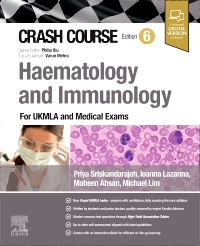
Crash Course Haematology and Immunology, 6th Edition
Paperback

Now $38.94
Crash Course – your effective every-day study companion PLUS the perfect antidote for exam stress! Save time and be assured you have the essential information you need in one place to excel on your course and achieve exam success.
A winning formula now for over 25 years, having sold over 1 million copies and translated in over 8 languages, each series volume has been fine-tuned and fully updated to make your life easier. Especially written by senior students or junior doctors/residents – those who understand what is essential for exam success – with all information thoroughly checked and quality assured by expert Faculty Advisers, the result is books that exactly meet your needs and you know you can trust.
Each chapter guides you succinctly through the full range of curriculum topics in the MLA syllabus, integrating clinical considerations with the relevant basic science and avoiding unnecessary or confusing detail. Text boxes help you get to the hints, tips and key points you need fast! A fully revised self-assessment section matching the latest exam formats is included to check your understanding and aid exam preparation. The accompanying enhanced, downloadable eBook completes this invaluable learning package.
Series volumes have been honed to meet the requirements of today’s medical students, although the range of other health students and professionals who need rapid access to the essentials of haematology and immunology will also love the unique approach of Crash Course. Whether you need to get out of a fix or aim for a distinction Crash Course is for you!
This updated edition features brand new high-resolution colour images of commonly tested blood films, vivid photographs of haematological skin manifestations, and revamped immunology sections. All new OSCE cases as well as MLA style questions, it covers cutting-edge immunological advancements including mRNA vaccines, biologics, and CAR-T therapy, providing an essential visual and theoretical resource for students.
-
- Fully aligned to MLA requirements, with key ‘conditions’ and ‘presentations’ highlighted in handy checklists - save valuable revision time and be confident you have the syllabus covered
- Updated self-assessment section matching the latest exam formats – confirm your understanding and improve exam technique fast
-
1 Principles of haematology
Principles
Blood
Blood cells
Haematopoiesis
Bone marrow
The spleen
Lymphadenopathy
2 Red blood cells and haemoglobin
Erythrocytes
Erythropoiesis
Haemoglobin
Myoglobin
Iron and haem metabolism
Haemoglobin metabolism
Red cell cytoskeleton
Red cell metabolism
Methaemoglobinaemia
Full blood count and reticulocyte count
Peripheral blood film
3 Red blood cell disorders
Anaemia
Anaemia secondary to haematinic deficiency
Anaemia of chronic disease
Anaemia due to blood loss
Microcytic anaemia: other causes
Haemolytic anaemia
Antibody-mediated haemolysis
Intrinsic red cell defects causing haemolysis
Other causes of haemolysis
Haemoglobinopathies
Electrophoresis: investigation of haemoglobinopathies
Marrow defects causing anaemia
Polycythaemia
4 White blood cells
Leucocyte structure
Leucocyte differentiation
Left and right shift
White count differential
Leucocytosis
Leucopoeni
5 Haematological malignancies
Introduction
Myeloproliferative neoplasms
Myelodysplastic syndromes
Leukaemias
Acute leukaemias
Chronic leukaemias
Malignant lymphomas
Age-specific haematological malignancy risk
Plasma cell dyscrasias
Investigations in haematological malignancy
Chemotherapy and targeted treatments
6 Haemostasis
Introduction
Platelets
Antiplatelet drugs
Platelet disorders
The coagulation cascade
Traditional pathways
Currently accepted pathway
Regulation of coagulation
Fibrinolysis
Overview of haemostasis
Coagulation assays
Clotting factor disorders
Hereditary factor deficiencies
Thrombosis
Secondary (acquired) thrombophilias
Primary (hereditary) thrombophilias
Venous thromboembolism
Anticoagulation
Thromboprophylaxis
Therapeutic thrombolysis
7 Blood transfusion
Introduction
Red cell antigens
The ABO blood group system
Rh blood group system
Other red cell antigens
Red cell transfusions
Alternatives to red cell transfusions
Other transfusion products
Transfusion reactions
Major haemorrhage
8 Principles of immunology
An introduction to immunology
9 The innate immune system
Barriers to infection
Cells of innate immunity
Soluble proteins
Innate immune system pattern recognition molecules
10 The adaptive immune system
The immunoglobulin domain
Generation of antigen receptor diversity
Humoral immunity
Cell-mediated immunity
Tolerance
11 The functioning immune system
Response to tissue damage
Immune response to pathogens
12 Immune dysfunction
Hypersensitivity
Type I hypersensitivity (immediate hypersensitivity)
Type II hypersensitivity
Type III hypersensitivity (immune complex)
Type IV hypersensitivity (delayed-type hypersensitivity)
Immune system disorders (instead of ‘development of hypersensitivity’)
Examples of autoimmune diseases
Immune deficiency
Investigation of a patient with possible immune deficiency
13 Medical intervention
Immunization
Transplantation
Medications used for the prevention of immune rejection
Cancer immunotherapy
Self-Assessment
MLA High Yield Association Table
MLA Single Best Answer (SBA) Questions
MLA SBA Answers
Short Cases
Glossary
Index

 as described in our
as described in our 